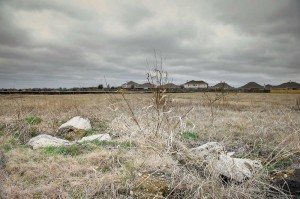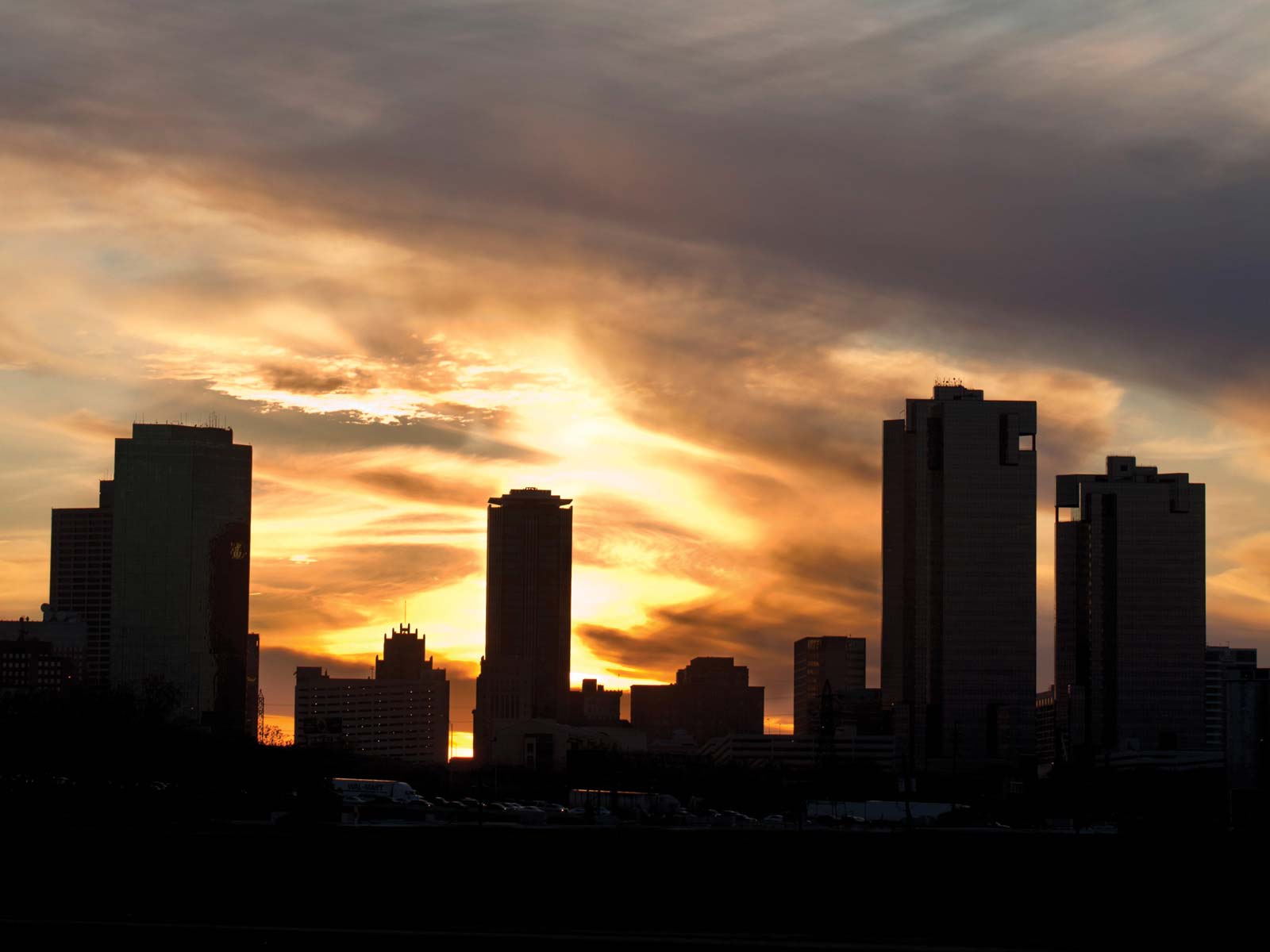
Blogger and drilling activist Sharon Wilson, who helped advise the Westchester group, said that she’s sure there’s a link between extraction and seismic activity.
“They are saying that not only fracking can damage a dam, but also extraction, which makes sense because that causes subsidence,” she said. “They haven’t said the earthquakes in this area are caused by extraction, but you know they’ve got to be.”
A study published last year in the scholarly journal Earth and Planetary Science Letters concluded that the extraction process is likely the cause of the suddenly common earthquakes in the Eagle Ford Shale near San Antonio.
******
A turquoise rod sticks up about two feet above the surface of an enormous dirt field. The rod marks Chesapeake’s well near the Joe Pool Dam, which wasn’t plugged until April 2014. The Oklahoma-based energy company had planned to drill up to four more wells on the same pad site. The problem was, the site was less than 850 feet from the dam, and residents like Carl Dimon, who worked for Exxon as a petroleum engineer for more than 30 years before he retired early in 1995, were concerned for public safety.
“I wrote a letter to the Corps and asked, ‘Are you aware this well is being drilled within 850 feet of this dam? Do you have any studies that indicate that is safe?’ I do that because, in spirit, I’m still a registered professional petroleum engineer, and our code of ethics says we should be concerned with public safety. God only knows what happens if that dam fails.”
When the Corps replied to Dimon’s letter, he said, they told him they had no knowledge of a drill site that close to one of their dams.
Chesapeake sent the federal agency a form letter — not addressed to any specific individual — just like those sent to other residents in the vicinity of the well.
“It very likely ended up in the trash,” said Read. “They sent [the Corps] the same form letter they send to residents to inform them of drilling in the neighborhood. They claim that meant the Corps knew what was going on.
“The right hand doesn’t always know what the left hand is doing,” she said. “[The Army Corps] knew nothing about fracking on a well in 2010. That was the revelation that came out of conversations I’ve had with people from the Corps. They couldn’t do anything anyways, because the site was on private land.”
Texas Railroad Commission records confirm that Chesapeake was planning to drill the four additional wells on what the company called its Corn Valley pad site. E-mails obtained from the Corps show that Chesapeake was preparing to move forward with the additional drilling even after the Corps enacted its moratorium.
Susan Read said state records show the well never produced. Dimon believes that Chesapeake put lives in danger for a well that was never going to be profitable.
“I’ll tell you, Chesapeake flat-ass lied about how much gas they were going to recover,” he said. “It has not been the economic windfall it was reported to be.”
The years since haven’t been good for Chesapeake, which has all but disappeared from the Barnett Shale. Company officials declined to comment for this story.
Now a developer is planning to build a housing development on the site of the abandoned well.
The city will not require soil or groundwater testing for the 43-plus-acre plot that was used for shale gas mining operations between 2010 and 2014. A city staffer told Westchester residents that the $60,000 price tag for testing was too high. Nor will the developer be required to disclose the land’s past to prospective homebuyers.
******













Thank you Fort Worth Weekly for this story about our community. A few additional details:
1. The Corn Valley Pad Site’s well that is pictured as abandoned and plugged never produced because it never had a gas gathering pipeline. Our group fought the pipeline during 3 City Council Meetings that ended with a vote of Denial by our Council in early January 2012. Our argument centered on how the City of Grand Prairie’s Moratorium Ordinance had to do with “gas drilling activities,” within 3,000 FT of all water retention structures and putting a well online for production was in our minds a “gas drilling activity.” The city was being paid a “lump sum” of over $500,000 to allow this system of gathering pipelines and transmission lines to be placed in Southern Grand Prairie for transporting gas from drilling sites in the area. We didn’t want the pipeline and we didn’t want the well to go “online” because of the Moratorium and because the USACE study was ongoing about gas drilling activities near the Joe Pool Lake Dam. Chesapeake, the City of Grand Prairie and the pipeline gathering company (DFW Midstream) almost got it done during the 2011 Christmas holiday season.
2. From the *new* March 17, 2011 Southwest District Policy statement (developed during the USACE Moratorium from January to June 2011): “33 USC 408 provides that it is unlawful for any person to impair the usefulness of any flood control work built by the United States. “ Meaning: Southwest District USACE currently has the authority to stop ALL gas drilling activities surrounding their dams if it is determined that these activities harm their projects.
3. With regard to the 3 XTO wells that are currently in production just to the west of the former Corn Valley Pad Site and within the 3,000 FT USACE Exclusion Zone, these wells are only extracting shale gas from a portion of Bureau of Land Management property. They too, are mostly located on private property. The BLM holds a 45-acre tract of land within the Lynn Unit’s pooled unit. According to our conversations with the BLM, this is simply a tract of land and not considered in the same way as federal land that completely surrounds and is below a USACE dam. (The Joe Pool Reservoir sits atop private land because it was not a USACE project originally and USACE came in later to manage its completion.) The City of Grand Prairie has declined to place these 3 XTO wells under the Moratorium even though extraction is known to cause subsidence. USACE won’t do it either. Apparently, stopping extraction (production) might land someone in court. It would be considered a “taking” so we’ve been told.
4. The Baldwin Hills Dam catastrophe provided a frightening example for what we don’t want to happen to our community. Dams are serious business. They need our attention.
____________
Susan Read
WCGPCA
Susan –
I know of an on-going study in Oklahoma that should shed light on extraction and deep well injection as they relate to increased earthquake potential. I think it will be discussed at the south central section meeting of the Geological Society of America meeting in Stillwater, OK on March 18-20, 2015. The frequency of earthquakes in central and south central OK has been even greater than in north and west TX.
Oklahoma is definitely much worse than North Texas at this point. It sometimes seems Texas’s fracking waste is being hauled up I35 to Oklahoma since North Texas cities mostly don’t allow disposal wells. Many of us receive the USGS Alerts in our Inboxes and it is worse than any spam. If everyone would sign up for those alerts it might be more alarming to the public. The residents of Medford and Cherokee are being pounded hard every day and night. Thank you for the information about the meeting. Are there any geologists not related to oil and gas in America? Maybe there will be some tenacious reporters who can get a good story or two.
While we are on the subject of fracking dams you might find it interesting to know that Squaw Creek damn has also been Fracked. Squaw Creek is the name of the lake that provides water to Comanche peak nuclear power plant.
This video will give more details http://youtu.be/mf1B61WbB7Q
While we are on the subject of fracking dams you might find it interesting to know that Squaw Creek damn has also been Fracked. Squaw Creek is the name of the lake that provides water to Comanche peak nuclear power plant.
This video will give more details
While we are on the subject of fracking dams you might find it interesting to know that Squaw Creek dam has also been Fracked. Squaw Creek is the name of the lake that provides water to Comanche peak nuclear power plant.
This video will give more details http://youtu.be/mf1B61WbB7Q
David, definitely frightening.
But just to clarify the information on the video from 2011 at the link, there was only one (1) well completed near this Texas nuclear facility (as shown in the screen shot in red) ~ Well 2H as depicted in the video. It was definitely drilled and fracked. And that is definitely a problem. The other two wells were permitted by the Railroad Commission of Texas but never completed (they were neither drilled nor fracked). Production commenced for Well 2H in March 2010 and ceased in January 2011 according to production data on the RRC website…at the same time as USACE was made aware of the issue of fracking near their dams and placed their own Moratorium on dams in their southwest district. We should all be concerned hydraulic fracturing ever happened at all. It appears that USACE did, in fact, manage to stop gas drilling, fracking and production activities from this location in early 2011.
Production Data for Well 2H (March 2010 through January 2011):
http://bit.ly/1FbkisU
Just to keep in mind: 1) Our state’s regulatory agency for Oil and Gas (The Railroad Commission of Texas) does not have rules for drilling operations near our Texas dams; 2) USACE (the Federal agency that manages so many of our dams) does not have statutory authority for stopping drilling operations on PRIVATE land that most often surrounds their dams in the USA; 3) Therefore, a local municipal ordinance (Local Control) was essential for USACE’s ability to stop drilling activities close in and around the Joe Pool Dam in our Westchester community in 2011. The gas drilling industry has conducted tons of drilling and fracking around our Dams in heavily populated areas in North Texas. Much of this activity that was within 3,000 FT of the federal dams was halted by USACE in early 2011. But what about all the other “privately-controlled” Dams in North Texas? A big one in Arlington comes to mind.
So, our Texas legislature is meeting right now in Austin. Is this serious issue on their agenda?
Susan
WCGPCA
Thank you Eric Griffey. Another notch on the fracking gun issue for the Weekly that the S-T didn’t get. Keep up the pressure and we might get to plug some wells in FW someday.
Some might suggest, Don, that we have some hammer-headed, greed-headed, rats in our sweet community that should be plugged. One of them was Mayor here in Foat Wuff not long ago. Don’t you know?
Unfortunately, like most civil infrastructure in our country, it will take a catastrophe to get the attention of federal and state regulators. The Texas Dam Safety Program has tried for years, maybe a decade now, to secure funding for dam safety inspections, as well as provide a mechanism for dam owners to obtain assistance for rehabilitating their dams. The Texas Legislature has not and still does not see it as a priority. However, in the event of a dam failure that, God forbid, kills people, I suspect that the Legislators will be quick to point the finger back at the TCEQ Dam Safety Program. When you add in the greed of oil & gas companies, City’s with dire budgets, property developers and your fellow private property owner, it makes the situation that much worse. Current State Dam Safety Rules require that oil & gas activities be at least 500 ft away from a dam, unless the oil & gas operator can show by scientific study that operating closer will cause no damage. First of all, 500 ft is too close to begin with. Second, what happened to common sense? Third, there is no coordination between state dam safety and federal agencies on this matter. Fourth, a study of this nature would be extremely difficult at best and would likely come from someone bought and paid for by a special interest group. And finally, where is the Texas Railroad Commission in this entire process? I tried calling them once to ask about regulations related to oil & gas operations in the vicinity of a dam in west Texas and was literally pass from person to person within the agency five times and the last person sent me back the the first person that I spoke with. I’ve dealt with numerous state and federal agencies during my career and I have never experienced one so disorganized and powerless in the face of oil & gas interests as the Texas Railroad Commission. Sad state of affairs…..